Friday, March 31, 2006
Great Balls of Fire II
Saturday, March 25, 2006
Daytime Venus II (Sunday 26 March)
 Orientation of Venus and the Moon, morning of Sunday March 26 (click to enlarge). I know I keep on banging on about seeing Venus in the Daytime (see here and here), but it is pretty amazing to see a planet in broad daylight.
Orientation of Venus and the Moon, morning of Sunday March 26 (click to enlarge). I know I keep on banging on about seeing Venus in the Daytime (see here and here), but it is pretty amazing to see a planet in broad daylight.However, seeing a dot, even a bright one, in the vast expanse of blue can be hard, but it helps if you have a guide. Tomorrow (Sunday 26 March), the Moon will be around 5 degrees (just under a handspan) to the left/north of the crescent Moon. The Moon should be fairly obvious. An hour or so after the Sun sets, find a nice spot where the Sun itself is blocked from view (remember always be VERY careful and NEVER look directly at the Sun, as you can permanently damage your eyesight), but there is a good clear northeast sky. Look up to about 3/4 of the way to the Zenith (60 degrees or about 10 handspans) in a just north of easterly direction and the crescent Moon should be obvious. Look to the left of the Moon by about 4 finger widths (roughly 5 degrees) and Venus should be an obvious bright dot (check the illustration for orientation).
You don't have to confine yourself to an hour after sunrise, but as the Sun rises higher it's harder to find objects to block it out that leave the Moon clear. As the Moon rises in the sky and passes the Zenith, Venus is north/below the Moon. You do need to look before about 4 pm, as the Moon and Venus will be too low to make out properly.
Good Luck, and don't forget to avoid looking at the Sun.
I'm Baaacckk!
Thursday, March 23, 2006
Starlight, Starbright
Saturday, March 18, 2006
Animated Pojmanski
Thursday, March 16, 2006
Talk Amongst Yourselves
See Venus and the ISS in Southern Australia
 The ISS passing Venus as seen facing east in Melbourne at 5:38 AEDST on 20 March, the view is pretty similar at other sites (click to enlarge)
The ISS passing Venus as seen facing east in Melbourne at 5:38 AEDST on 20 March, the view is pretty similar at other sites (click to enlarge)Venus is spectacular at the worst of times, but on the Morning of Sunday March 19, for those in Adelaide and Hobart, and the Morning of Monday March 20, for those in Melbourne and Sydney, the International Space Station will glide past Venus. This will be a pretty great sight. Hobart has the closest approach of the ISS to Venus, followed by Melbourne, Sydney and Adelaide (it's in roughly the same half of the sky in Brisbane).
Times:
Adelaide: 19 March Closest approach 6:18 ACDST, Mag 0.7
Hobart: 19 March Closest approach 5:13 AEDST, Mag 0.6
Melbourne: 20 March Closest approach 5:38 AEDST, Mag 0.6
Sydney: 20 March Closest approach 5:40 AEDST, Mag 0.7
The ISS orbit changes a lot, so you might want to check approach times either directly at http://www.heavens-above.com or via my handy preset forms at http://home.mira.net/~reynella/skywatch/ssky.htm#Flare
Wednesday, March 15, 2006
Flying Valles Marineris
I'm a little dissapointed.
And to complete things, now it is raining.
Using Google Earth to Hunt for Impact Craters
Tuesday, March 14, 2006
OGLEing Neptune-sized planets for MicroFUN
You can read the full article at Arxiv astro-ph/0603276 by choosing one of the download options (the PDF file is here). Neither the OGLE nor the microFUN home pages mention the discovery yet. In gravitational microlensing, a foreground star's gravity well magnifies a background stars light, if there are planets around the lensing star, the brightening will be distorted in specific ways, depending on the size of the planet. The microlensing method is most sensitive between 2-4 AU out, so don't expect Earth size planets to be picked up soon, but it nicely complements both the radial velocity and transit methods of detecting exoplanets.
While the ABC release calls the planet "Earth like", we have no idea if it is a gas dominated world like Neptune, of a bare rock and ice core.
Monday, March 13, 2006
Google Mars!
 With a tip of the hat to Davep! Google Mars is fantastic. Google Moon was a bit of fun, but this is a serious resource. You have genuine Mars maps in exquisit detail, you can choose from coloured topgraphic maps, black and white visible light maps and infrared maps. You can search for features, and it has pre-searched feature groups (Mountains, canyons dunes etc.) which you can browse through. As well there are links to NASA articles about special reigions. You will spend ages exploring these maps, book mark them today.
With a tip of the hat to Davep! Google Mars is fantastic. Google Moon was a bit of fun, but this is a serious resource. You have genuine Mars maps in exquisit detail, you can choose from coloured topgraphic maps, black and white visible light maps and infrared maps. You can search for features, and it has pre-searched feature groups (Mountains, canyons dunes etc.) which you can browse through. As well there are links to NASA articles about special reigions. You will spend ages exploring these maps, book mark them today.Moon over Womadelaide
 The Moon rising over Womadelaide.
The Moon rising over Womadelaide. As I've noted before, binoculars are pretty good buys. Not are they a handy portable astronomical tool, they can be used to do bird and whale watching, as well as desperately trying to see any of the acts at Womadelaide through a sea of heads. Womadelaide is one of the site or the Womad series of World Music Festivals. The Bettdeckererschnapender weisle and I are folk music buffs from way back, we met at a folk/acoustic music venue and were volunteers at the Port Fairy Folk Music festival for many years BC (Before Children).
Womadelaide is an excellent Festival, and has the advantage of being in the heart of our adopted city, rather than 8 hours drive away (which is how long it now takes us to get to Port fairy). Womadelaide is held in Botanic park, which is a great location with stages nestled into giant Morton Bay figs with tortuous rootts. It runs three days and nights. The Saturday was a bit intense, with temperatures rising to 37 degrees C. We spent large amounts of time huddled under the trees in a shrinking patch of shade listening to some amazing acts such as The Saltwater Band from Elco Island in NT (managed by a friend of ours) and La Bottine Souriante (The Smiling Boot) an amazing French Canadian group whose percussion is provided by tapdancing (that may sound stupid, but it was amazingly effective, and was one of our favorite groups). In the evening, it cooled down to a frigid 25 Degrees C, and I watch the Moon rise over Womadelaide, and the stars come out, to the accompanyment of some terrific music. Almost literally 'Music of the Spheres".
 There was some truly inspirational music as well. The Golden Pride children's Choir is a group of children from rural villages in Tanzania, who have amazing voices and do beautiful acappella music. They have raised the money to come to Womadelaide themselves, and any profit from their tour goes to building a high school for their community. And if you but their CD from their website, you will be contributing to their community school as well.
There was some truly inspirational music as well. The Golden Pride children's Choir is a group of children from rural villages in Tanzania, who have amazing voices and do beautiful acappella music. They have raised the money to come to Womadelaide themselves, and any profit from their tour goes to building a high school for their community. And if you but their CD from their website, you will be contributing to their community school as well.  Sunday couldn't have contrasted more with Saturday, it rained. Now we had to compete with umbrellas as well as heads. We still huddled under the same trees, but trying to avoid soaking instead of heat stroke. Still were saw some amazing things, including a massive percussion jam lead by Johnny Kalsi of the Dhol Foundation and featuring the fantastic Singaporean percussion ensemble Wicked Aura Batucada. We came home sodden but happy.
Sunday couldn't have contrasted more with Saturday, it rained. Now we had to compete with umbrellas as well as heads. We still huddled under the same trees, but trying to avoid soaking instead of heat stroke. Still were saw some amazing things, including a massive percussion jam lead by Johnny Kalsi of the Dhol Foundation and featuring the fantastic Singaporean percussion ensemble Wicked Aura Batucada. We came home sodden but happy.Friday, March 10, 2006
2004 VD17, the sword of Damocoles it's not.
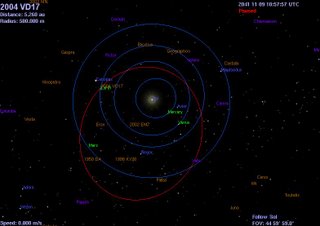 Click image (generated in Celestia) to enlarge enough to see the orbits. Asteroid 2004 VD17 was briefly the bet noire of the asteroid world. For a short while it was at the unheard of level 4 in the Torino scale, with a 1 in 1000 chance of hitting Earth in 4 May 2102. It was subsequently degraded and now is only Torino scale 2. It seems to have fallen even further. The NEODys page lists 2004 VD17 as coming within 0.013 au of Earth in 7 November 2041, but when I plug the latest elements from the minor planet centre into SkyMap, it comes no closer that 0.16 au. Now it could be that SkyMap isn't as precise as NEODys over that period of time. I plugged these elements into Celestia, and it doesn't come close in this program either (they basically agree). I've generated a Celestia SSC file for 2004 VD17 that you can download here. Have a play with it, but you won't get any images of 2004 VD17 hanging over earth like I could with 2001 MN4.
Click image (generated in Celestia) to enlarge enough to see the orbits. Asteroid 2004 VD17 was briefly the bet noire of the asteroid world. For a short while it was at the unheard of level 4 in the Torino scale, with a 1 in 1000 chance of hitting Earth in 4 May 2102. It was subsequently degraded and now is only Torino scale 2. It seems to have fallen even further. The NEODys page lists 2004 VD17 as coming within 0.013 au of Earth in 7 November 2041, but when I plug the latest elements from the minor planet centre into SkyMap, it comes no closer that 0.16 au. Now it could be that SkyMap isn't as precise as NEODys over that period of time. I plugged these elements into Celestia, and it doesn't come close in this program either (they basically agree). I've generated a Celestia SSC file for 2004 VD17 that you can download here. Have a play with it, but you won't get any images of 2004 VD17 hanging over earth like I could with 2001 MN4.Venus and Beta Capricornii
 A greatly over exposed Venus lurks next to Beta Capricornii in this image th visual double star alpha Caprciornii is off to the left. (click to enlarge) On Saturday morning Venus will eb right next to Beta Cap. If you are up to see this, catch the NASA TV webcast of the arrival of the Mars Reconnaissance Orbiter. I won't be able to see it as we have guests staying in the computer room.
A greatly over exposed Venus lurks next to Beta Capricornii in this image th visual double star alpha Caprciornii is off to the left. (click to enlarge) On Saturday morning Venus will eb right next to Beta Cap. If you are up to see this, catch the NASA TV webcast of the arrival of the Mars Reconnaissance Orbiter. I won't be able to see it as we have guests staying in the computer room.Thursday, March 09, 2006
Mars Reconnaissance Orbiter About to Arrive
 Image Credit NASA
Image Credit NASAThe Mars Reconnaissance Orbiter will begin braking and hopefully go into orbit sometime on March 11 Australian time (March 10 US time), rather than burning up or smacking into Mars. NASA TV will start broadcasting the insertion maneuver around 7.00 am AEST (6.30 am ACDST) Saturday March 11. So if you have been up early watching Venus next to beta Capricornii, they hang around for the broadcast.
Tuesday, March 07, 2006
Stunning Shots of Olympus Mons from Mars Express
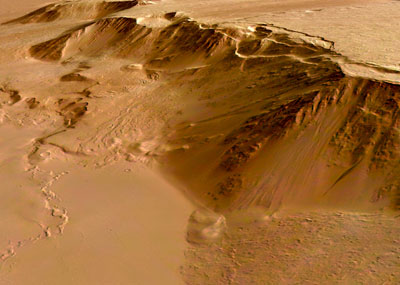 Image Credit ESA. This beautiful image is a synthetic view of the scarp at the base of the volcanoe Olympus Mons, calculated from high resolution images taken by Mars Express.
Image Credit ESA. This beautiful image is a synthetic view of the scarp at the base of the volcanoe Olympus Mons, calculated from high resolution images taken by Mars Express.Solar Minimum is Here
 Image Credit NASA
Image Credit NASAWell, its official, the Solar Cycle Minimum is here. For all of February the Sun was virtually a blank disk. Experts predict that most of 2006 will be similar (although Solar Minimum might end after only a few months). This means solar activity (and hence aurora) will be quite low (but not necessarily absent). After the minimum Sunspot numbers an solar activity will begin to climb. How high will it go this time? NASA scientists, using new models of the solar magnetic field, have estimated that the coming cycle (which will peak in either 2011 or 2012) will be 50% stronger than the last cycle. Now this sort of prediction is still rather uncertain, but if so we have a better chance of amazing aurora in the coming years (and more chance of continent wide blackouts and satellite failures too). Some amazing images and videos are here which goes with the NASA story. See also this shorter version of the story.
Monday, March 06, 2006
Yet another Venus animation
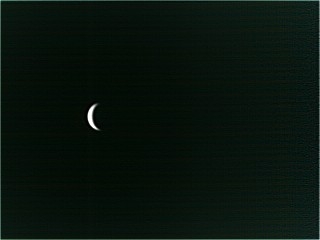 This is a preview of the Great Venus Animation (167 Kb). Just under a month of images shot roughly every 4 days. The animation is a bit wobbly, as each image isn't in the same exact orientation. I will fix this for the final assembly, and I've worked out a better way to overlay the images. Still, it's not looking too bad, compared to my animation of 2005 shots. Coming soon, Ian's guide to using The Gimp for astrophotography.
This is a preview of the Great Venus Animation (167 Kb). Just under a month of images shot roughly every 4 days. The animation is a bit wobbly, as each image isn't in the same exact orientation. I will fix this for the final assembly, and I've worked out a better way to overlay the images. Still, it's not looking too bad, compared to my animation of 2005 shots. Coming soon, Ian's guide to using The Gimp for astrophotography.Sunday, March 05, 2006
More Stunning Terragen Mars-scapes
Jupiter has a new Red Spot!
 (Image Credit, Christopher Go) Jupiter has a new red SPot, not as big as the famous Great Red Spot, but impressive just the same. See the original article at NASA Science or get Tom's take on it.
(Image Credit, Christopher Go) Jupiter has a new red SPot, not as big as the famous Great Red Spot, but impressive just the same. See the original article at NASA Science or get Tom's take on it. I'm going to see if I can image it. With my setup, it will be rather borderline, but it could work. The Jupiter image I've take has been rotated to be in the same orientation as Christopher Go's. The GRS is indicated by the black lines. I have to wait until the GRS has almost roated off for GRS Jr to be centre field, and that will be a while yet, bit I might be able to pick it up.
I'm going to see if I can image it. With my setup, it will be rather borderline, but it could work. The Jupiter image I've take has been rotated to be in the same orientation as Christopher Go's. The GRS is indicated by the black lines. I have to wait until the GRS has almost roated off for GRS Jr to be centre field, and that will be a while yet, bit I might be able to pick it up.
Well, I had to do it.
 | You scored as Moya (Farscape). You are surrounded by muppets. But that is okay because they are your friends and have shown many times that they can be trusted. Now if only you could stop being bothered about wormholes.
Your Ultimate Sci-Fi Profile II: which sci-fi crew would you best fit in? (pics) created with QuizFarm.com |
I was dissapointed with the choices though. Where's Valley Forge? Also where's Blakes Seven's ship Liberator, Dark Star, Heart of Gold, Solaris (well, the staion on Solaris) Nostromo and Red Dwarf??? I am so Red Dwarf.
It's cold outside. However, there is nothing wrong with the Universe that cannot be solved by a good, extra strong curry and travelling backwards in time. Now if you could only get the hologram to stop annoying you.
Friday, March 03, 2006
Io, now you see it, now you don't.
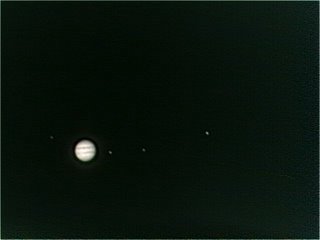 (click image to enlarge). The animation (Warning 860 Kb) is here. Timing is everything, in comedy, brain surgery and eclipses/occultations. I was up early Thursday morning for a triple feature, an eclipse of Io, the ISS passing just under Venus and of course our friend Comet Pojmanski. Now, for serious eclipse/occultation timers in Australia, life has been hard since the short-wave time signals were abandoned. My needs aren't so great, so I use my mobile phone. Telstra has set up some sort of automated time synchronization for their mobiles, my phone is the same to the minute as my computer when set up with atomic clock synch.
(click image to enlarge). The animation (Warning 860 Kb) is here. Timing is everything, in comedy, brain surgery and eclipses/occultations. I was up early Thursday morning for a triple feature, an eclipse of Io, the ISS passing just under Venus and of course our friend Comet Pojmanski. Now, for serious eclipse/occultation timers in Australia, life has been hard since the short-wave time signals were abandoned. My needs aren't so great, so I use my mobile phone. Telstra has set up some sort of automated time synchronization for their mobiles, my phone is the same to the minute as my computer when set up with atomic clock synch. Of course, none of this helps when you read the AEST of an event instead of the ACST. So there I was, trying to juggle images of the occultation of Io and the ISS flyby, which were supposedly nearly on top of each other. However, at the allotted time (by my notes) Io was very un-occulted, and the ISS passby was fast approaching. Was I going to have to run the webcam while trying to activate the cable release with my toes?. A quick rush back to the almanac revealed it was going to be half an hour later. All that panic for nothing!
Anyway, I am very happy with the animation. This represents an animation of 11 separate images roughly 5 minutes apart. I say roughly, as I had to do a planetary image first, the shoot the exposure up and do a Moon exposure. This resulted in 22 images (at 14 Mb each). I pasted the planet image over the overexposed Moons image to generate 11 unique images, then stacked the lot in The Gimp, and animated the stack. Not too shabby if I say so myself. The Great Red Spot rotates into center view (it looks more like a gap in the bottom cloud band), other cloud features can be seen to rotate. Io blinks out quite nicely (I actually caught it fading in one frame, but stacking messes that up a bit). The images aren't as crisp as I would like (the warm morning ment a more shifty atmosphere), but the rotation and orbiting of the Moons is reasonably smooth for a manual stacking. Next challenge, a shadow transit.
Where's Comet Pojmanksi now?
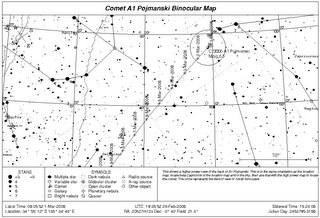 (click image for a larger, printable map, or go to Southern Skywatch's comet section for a better quality version). Pojmanski is below Alpha and Beta Capricornii, headed for the horizon, this is probably the last week for Southern Hemispherians to catch it.
(click image for a larger, printable map, or go to Southern Skywatch's comet section for a better quality version). Pojmanski is below Alpha and Beta Capricornii, headed for the horizon, this is probably the last week for Southern Hemispherians to catch it.Thursday, March 02, 2006
Occultation image
 (Click to enlarge image) The occultation of Antares was great!The sky was unfortunately a bit turbulent, but I was clearly able to see the Moon edging towards Antares with the unaided eye, binoculars and my trusty webcam. I've made an overlay of the best images in sequence. One AVI just wouldn't track, so there's a hole in the sequence, I also managed to send the scope off track just before Antares went behind the Moon, and had to do some frantic realingment. But I was successful, and I caught the moment when Antares went behind the Moon. It doesn't show up well in the overlay (Antares is a bit of a streak in the image), but if anyone wants a 14Mb AVI of Antares going behind the Moon, let me know.
(Click to enlarge image) The occultation of Antares was great!The sky was unfortunately a bit turbulent, but I was clearly able to see the Moon edging towards Antares with the unaided eye, binoculars and my trusty webcam. I've made an overlay of the best images in sequence. One AVI just wouldn't track, so there's a hole in the sequence, I also managed to send the scope off track just before Antares went behind the Moon, and had to do some frantic realingment. But I was successful, and I caught the moment when Antares went behind the Moon. It doesn't show up well in the overlay (Antares is a bit of a streak in the image), but if anyone wants a 14Mb AVI of Antares going behind the Moon, let me know.I'm a member of an occultation observing group. Occulataion timing of asteroid occultations can reveal the size shape and possibly Moons of an asteroid, so it can be pretty interesting. Until now I've done all my observing by eye. Unfortunately (with the exception of the magnificent occcultation of Jupiter) all the interesting occultations either missed me, or were clouded out. I wanted to see if the Webcam would be a good way to record (reasonably bright) occultations. Unfortunately, there is no good way to timestamp the image, and the files are WAY too big for standard occultation surveillance. But it's good for events like this.
The Things You See When You Don't Have A Camera II
 Click on image for a larger version.
Click on image for a larger version.As last time, the boys (eldest one and smallest one) and I were swimming, a thin but attractive group of Mares Tails came across the sky. The sun was low on the horizon, behind trees from where we were. Idly floating I noticed a faint patch of colour. A Sundog! My first one ever! I pointed it out to eldestone, who could see it better than I with his younger eyesight. I watched for a while as it faded. Coming back to the house I glaced back up at the sky. Another Sundog (update, it was actually a Tangent Arc, being directly above the Sun)! Intensely bright! I called the family to have a look, the Bettdeckererschnappender weisle was not impressed (she called it a "hole in the cloud"). I put the kids in the shower, rushed out to snap the above shot of the faded remanant, and went back to just fail to stop smallest one dismantling the bathroom.
A nice mornings work
As well as watching the twinkling stars fade into a beautiful dawn. There are worse ways to start the day.



 Click to read about or order
Click to read about or order Click to read about or order
Click to read about or order Click to read about or order
Click to read about or order Click to read about or order
Click to read about or order




